

The Fertile Soil of Sangha - Thich Nhat Hanh. I Vow Not to Burn Out. What is Tantra? A Primer on Tantric Meditation – OmStars. Tantra is as misunderstood in the West, where it’s become synonymous with sexual rituals, as in the East, where it’s considered magic alchemy.

But Tantra is actually a vast science that encompasses wisdom from Ayurvedic medicine, Samkhya/Yoga philosophy, Vedanta, Jyotish astrology and spiritual practices using yantras and mantras. The ultimate goal of Tantra is to systematically utilize all of the methods we can to accelerate transformation and help the practitioner to create a life that is richer and more complete. Its focus is on providing the correct approach and specific techniques to cause an individual to grow, become stronger and more capable by undoing all obstacles to freedom in the fastest way possible. The Practice of Kashmir Shaivism. This is a discourse on the ways which will lead an aspirant to one-pointedness in meditation and to the Awareness which he aspires.
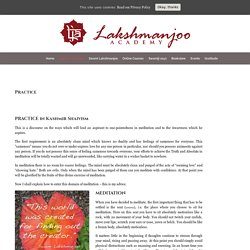
The first requirement is an absolutely clean mind which knows no duality and has feelings of sameness for everyone. This "sameness" means you do not over or under-express love for any one person in particular, nor should you possess animosity against any person. If you do not possess this sense of feeling sameness towards everyone, your efforts to achieve the Truth and Absolute in meditation will be totally wasted and will go unrewarded, like carrying water in a wicker basket to nowhere. In meditation there is no room for coarse feelings. The mind must be absolutely clean and purged of the acts of “seeming love” and “showing hate.
" Now I shall explain how to enter this domain of meditation – this is my advice. It matters little in the beginning if thoughts continue to stream through your mind, rising and passing away. In the Bhagavad Gita the Lord says: Breath. Faculty.washington.edu/kpotter/ckeyt/txt3.htm. 8 July 2017 10th through 14th century [For other time frames, or an alphabetical index, click on the images above.] 463.Author Unknown (900) 1.Kausikasutra (T.249) (NCat V, 116) 463.00 Edited with extracts from the commentaries of Darila and Kesava. 463.0 Translated into German by W. 463.1.1 Edited by Edward Conze, SIS 5.2, 1956. 463.1.2 Edited in Bailey Volume 3, 102, 118-119 463.1.4 The Savayavajnas (60-68) translated by J. 463.1.5 H.C.
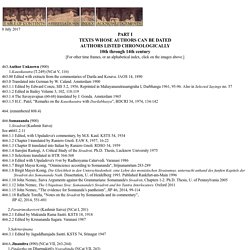
Kashmir Shaivism. The trident (triśūlābija maṇḍalam), symbol and yantra of Parama Shiva, representing the triadic energies of parā, parā-aparā and aparā śakti Among the various Hindu philosophies, Kashmir Shaivism (Kaśmir Śaivism) is a school of Śaivism consisting of Trika and its philosophical articulation Pratyabhijña.[1] It is categorized by various scholars as monistic[2] idealism (absolute idealism, theistic monism,[3] realistic idealism,[4] transcendental physicalism or concrete monism.[4]) The goal of Kashmir Shaivism is to merge in Shiva or Universal Consciousness, or realise one's already existing identity with Shiva, by means of wisdom, yoga and grace.[9][10] "Kashmir Shaivism has penetrated to that depth of living thought where diverse currents of human wisdom unite in a luminous synthesis. " - Rabindranath Tagore (9 May 1861 - 7 August 1941) Nobel Prize in Literature (1913).
[citation needed] Origin[edit] Concepts[edit] Philosophical overview[edit] Anuttara, the Supreme[edit] Pratyabhijna. Pratyabhijna (Sanskrit: प्रत्यभिज्ञा, translit. pratyabhijñā, lit. 're-cognition') is an idealistic monistic and theistic school of philosophy in Kashmir Shaivism, originating in the 9th century CE.
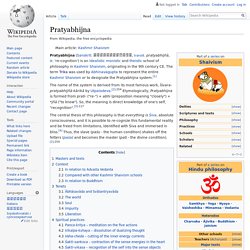
The term Trika was used by Abhinavagupta to represent the entire Kashmir Shaivism or to designate the Pratyabhijna system.[1] The name of the system is derived from its most famous work, Īśvara-pratyabhijñā-kārikā by Utpaladeva.[2]:254 Etymologically, Pratyabhijna is formed from prati- ("re-") + abhi (preposition meaning "closely") + *jñā ("to know"). Trika. Trika is a non-Saiddhantika Mantra Margic sect developed by Kashmiri Shaivite philosopher Abhinavagupta.[1][2][3][4] The term Trika is used nowadays to refer the core philosophy of Kashmir Shaivism in counterpart with the Siddhanta Philosophy of Southern Shaivism.
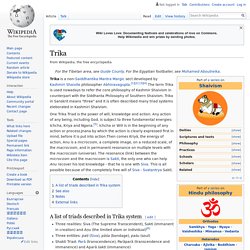
Trika in Sanskrit means "three" and it is often described many triad systems eleborated in Kashmiri Shaivism. Schools of Tantra: Kaula, Mishra, and Samaya. Schools of Tantra: Kaula, Mishra, & Samaya by Swami Jnaneshvara Bharati SwamiJ.com Tantra considers the universe to be a manifestation of pure consciousness.
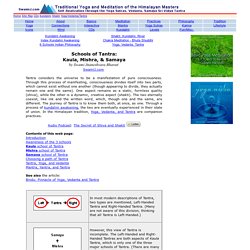
Kundalini Awakening - Kundalini Awakens. #4: Awakening the Kundalini energy: After one is well established in the ability to balance the Prana between Ida and Pingala (section #2), and causing it to flow in Sushumna (section #3), the resulting sense of peace and joy is the foundation for the next step, which is awakening the Kundalini itself.

Kundalini Awakening is for all: Regardless of what religious, spiritual, or meditation tradition one follows, the awakening of this Kundalini energy, by whatever name you call it, is a most innate and essential part of spiritual advancement, unfoldment, or realization. It may seem different when colored by different cultures, but the fundamental experience of the energy is there nonetheless. Preparation is imperative: It is easy to read the descriptions in the books about Kundalini Awakening and the union of Shiva and Shakti, and to want to have this immediately.
This seems to be a natural desire, that is useful if properly channeled into the motivation to do the practices. Kundalini Awakening - Prana flows in Ida OR Pingala. Yoga Sutras of Patanjali 2.49-2.53: Pranayama and breath control, rung #4 of 8. Varieties of Pranayama. "Bahya-abhyantara-stambha-vrittih-desa-kaala- sankhyabhih paridrishto deergha-sukshmah.
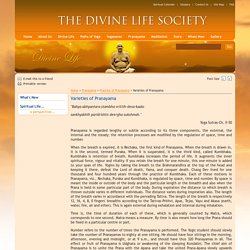
" Yoga Sutras-Ch.